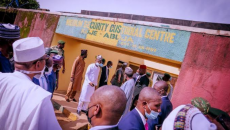Abdullahi Ibrahim Maikano, secretary of Universal Service Province Fund, USPF, an agency established under the NCC Act to drive telecoms services in rural locations across the country, explains how the fund is improving telecoms infrastructure in remote locations in this interview with Anayochukwu Agbo, general editor; and Tony Manuaka, associate editor
 To what extent are you actualising the mandate of USPF?
To what extent are you actualising the mandate of USPF?
We have done pretty well. We come up with programmes and projects. We look at them from two perspectives in other to ensure that our mandate is fulfilled: one is driving connectivity by making sure that telecoms infrastructure are expanded to rural areas and the other is providing last mile access to ensure that rural people also have access to telecoms services. It is not enough to get the infrastructure to rural areas without ensuring that those services are actually used. Without our intervention, a lot of the network operators would not have extended their facilities. So we provide subsidy for operators to extend those facilities, popularly known as BTS (Base Transmission Station). We just recently launched some in Ondo State to cover half a million population. So we have been building this BTS along with operators. All the major operators are working with us. They extend their services to those places and we give them subsidy for that. On the services side we have been promoting ICT usage because like I said if you provide the infrastructure to these places and there is nobody to use it, it becomes a waste of money. So you need to make people aware and willing to use those services. That’s why we are busy providing Internet and computers to schools, both secondary schools, universities; establishing e-libraries and so on so forth. Establishing community communication centres, so that you create an army of users, people who actually depend on ICT generally for their day-to-day lives. We also train youths on ICT; on entrepreneurship so that they can set up some ICT business services that will further deepen the use of ICT in the country.
Between 2010 and 2015 what are the specific achievements USPF has made under this four years?
From 2010/2011 we decided to identify those un-served locations by ourselves. Identify the communities, who are this people, where are they staying, what services do they need and then document it [in] half a database and say okay this is the number of people that we think don’t have services. And these are the type of services from our own interaction with them, our study, these are the kind of thing we feel they will need. We document that and at that point you will now know the constituency that are served and then you will be able to appreciate the magnitude of the kind of job, what really that mandate is talking about. So this is a kind of milestone for us because data is very important; without database you will only be guessing. We are not doing guesswork now; we know how many people that we are looking at. This is a significant achievement because we are talking about our mobile penetration. In a population of 170 million we have about 130 million. Now from a layman’s perspective you subtract that 130 from 170 and you will this is the number of people that have lines and these are the numbers that do not have lines. But that is not as easy as that because most of the 130 SIM cards that you see are amongst the 100 million or so of Nigerians that are within the cities.
A lot of areas outside the major cities don’t have access; it is not because they don’t have money but because the services didn’t reach there. So we are able to know in all the six geo-political zones, zone by zone, town by town, community by community, how many people and that is a major achievement because now we can actually plan and you make judicious use of your resources.
How did you get this data?
We did this data by engaging consults; we also engaged consultants to go round with us. There is also sit data, (we call it), which resides with the various operators; every operator has its own. So we collected them and put it together as one. Then we did field work to verify where this station, this infrastructure they have built where they are allocated and who and who is actually having access to services in those locations. Using that, we are now able to isolate those areas, those communities that don’t have service.
From what you have told us your office seemed to have covered quite a large part of this country, trying to put in place telecoms infrastructure and services. Can we get more details on what these infrastructures and services are and in what locations?
Beginning from 2010 till date we have built about 250 BTSs which in terms of population is about 10 million more Nigerians who now have access to mobile telephony as a result of that from the creation of USPF in 2006 to 2010 only 50 were built. From 2010 to date we are talking about 250 so you can see the achievement.
From our study we realised that we need to build at least 10,000 BTSs for everybody in this country to be able to use telephone services. We didn’t know that before. By 2010 we didn’t know that the number of people that are part of the population. We didn’t know there is need for us to provide subsidy for building of at least 10,000 BTSs.
How do you fund your projects?
Every year 40 per cent of NCC’s revenue is transferred to the USPF. We have also built about average of 2000 kilometres of fibrotic cable yearly from 2011. So when you now calculate maybe two times three is about 9000 kilometres of fibrotic we have extended to places where without our own intervention they will not have access to fibre. Without fibre backbone transmission there is no 3G; the simple 3G on your phone.
Would you consider your intervention critical to the telecoms revolution in Nigeria?
Yes! Our interventions are critical to telecoms revolution in Nigeria. For instance, without the BTSs you will only be getting services in the urban centres. There is a government project which is driven by NUC called the NG RAEN (Nigeria Research and Education Network). Government decided to establish NG RAEN which is connecting the entire Nigeria universities in a network that will enable them communicate more effectively. They can be able to share resources and content. They can even do online teaching and so on. So we at USPF have dedicated a lot of our resources to support the NG RAEN. We supported the NG RAEN by connecting 16 universities to that particular network and we will continue to do that until every university in this country is pushed into that network. So we need more money, the challenge is funding, we still need more money to do that and the time to do it is now because from our own estimation we are looking at 40 million Nigerians not having access to telecommunication services. How long can you wait for 40 million Nigerians to remain unconnected? So it is huge and we need to move fast.
Our own projection is in the next three to four years we want to reduce the 40 million population that are now not having telecommunication services [to] less than maybe five million or so.
How has the insurgency affected your programmes in North-east?
Yes, it has. It has affected us seriously. In fact I can say that [there are] very few part of the North-east that we are able to do something on at the moment. What we do is we make sure all our project are nationally spread, so the allocations for the North-east we put it on hold until when things get better, they will be implemented. A lot of locations in Borno State and part of Yobe, we are not able to do a lot because of that.
What is your relationship with NCC like?
They are our source of fund. More importantly, NCC is also providing the overall supervision of the USPF. In terms of when we are looking at the universal service domain, places where we should extend our services. We also work hand in hand with NCC so that we don’t duplicate the efforts, so we will identify where their job ends, areas that they want to extend their services and then we will do that.
Follow Us on Social Media


 WhatsApp us
WhatsApp us